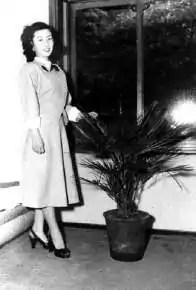Fujiko Yamamoto
Fujiko Yamamoto (山本 富士子, Yamamoto Fujiko) (born 11 December 1931) is a Japanese film and stage actress. She appeared in over 100 films between 1953 and 1963.[1] She won the first Grand Prix of Miss Nippon in 1950.[2]
Fujiko Yamamoto | |
|---|---|
 Fujiko Yamamoto in 1950 | |
| Born | 11 December 1931 Osaka, Japan |
| Occupation | Actress |
| Years active | 1953-present |
Career
Yamamoto was born on 11 December 1931, in Nishi-ku, Osaka, to a cotton wholesaler located in Senba. Raised in Izumi and then Izumiōtsu, she attended Hamadera Elementary School and began learning traditional Japanese dance from Rokunosuke Hanayagi (花柳禄之助) of the Rokuju Hanayagi (花柳禄寿[3]) school. She graduated from what is now Kyoto Ōki High School.
She won the first Miss Nippon beauty contest in 1950. In 1953 she made her film debut at the Daiei Studios.[3] She became one of Daiei's top actresses.
Yamamoto was considered one of Japan's most beautiful women, with "noble" features that represented the classic ideal of Japanese beauty.[4] As such, she was well-suited for costumed parts in the era's popular period dramas, with her less-frequent modern roles (in films like Ozu's Equinox Flower and Ichikawa's Being Two Isn't Easy) often shot in "movie star" closeups that placed her apart from the films' contemporary storytelling.[4][5]
In 1963, when her contract came up for renewal, she insisted on changes. The head of Daiei, Masaichi Nagata, refused, unilaterally fired her, and then invoked an agreement between the major studios to prevent her from working again in film.[3] Even though she has appeared frequently on stage and on television,[3] she has not appeared in a film since then.
Selected filmography
- (十代の誘惑 Jūdai no yūwaku) (1953)
- The Romance of Yushima (1955)
- A Girl Isn't Allowed to Love (1955)
- Suzakumon (1957)
- Equinox Flower (1958)
- Hitohada Kujaku (1958)
- The Loyal 47 Ronin (忠臣蔵 Chūshingura) (1958)
- The Snowy Heron (1958)
- Unforgettable Trail (1959)
- Satan's Sword (1960)
- Jokyo (1960)
- Being Two Isn't Easy (私は二歳, Watashi wa nisai) (1962)
- An Actor's Revenge (1963)
Awards
- 1959 Blue Ribbon Awards for Best Actress
- 1961 Kinema Junpo Award for Best Actress
References
- "Yamamoto Fujiko" (in Japanese). Retrieved 27 May 2009.
- 第1回1950年度ミス日本グランプリ 山本富士子 [The first Grand Prix of Miss Nippon in 1950] (in Japanese). The Official Miss Nippon Website.
- "Yamamoto Fujiko". Dejitaru-ban Nihon jinmei daijiten + Plus (in Japanese). Kōdansha. Retrieved 5 December 2010.
- Russell, Catherine (2001). Cinematheque Ontario: Kon Ichikawa. Indiana University Press. p. 257. ISBN 0968296939.
- "EQUINOX FLOWER (Higanbana)". Ozusan.com. Retrieved 22 April 2020.